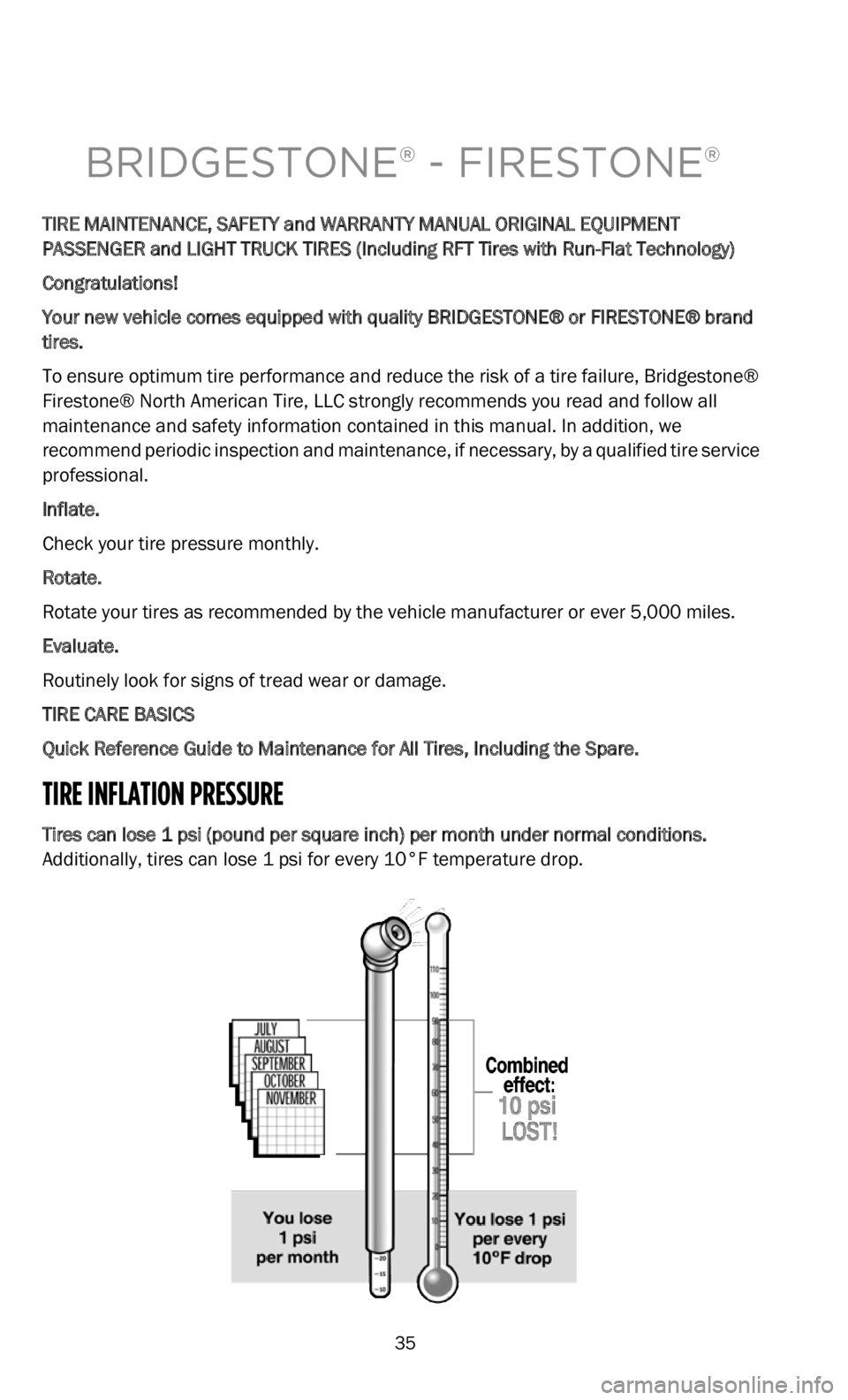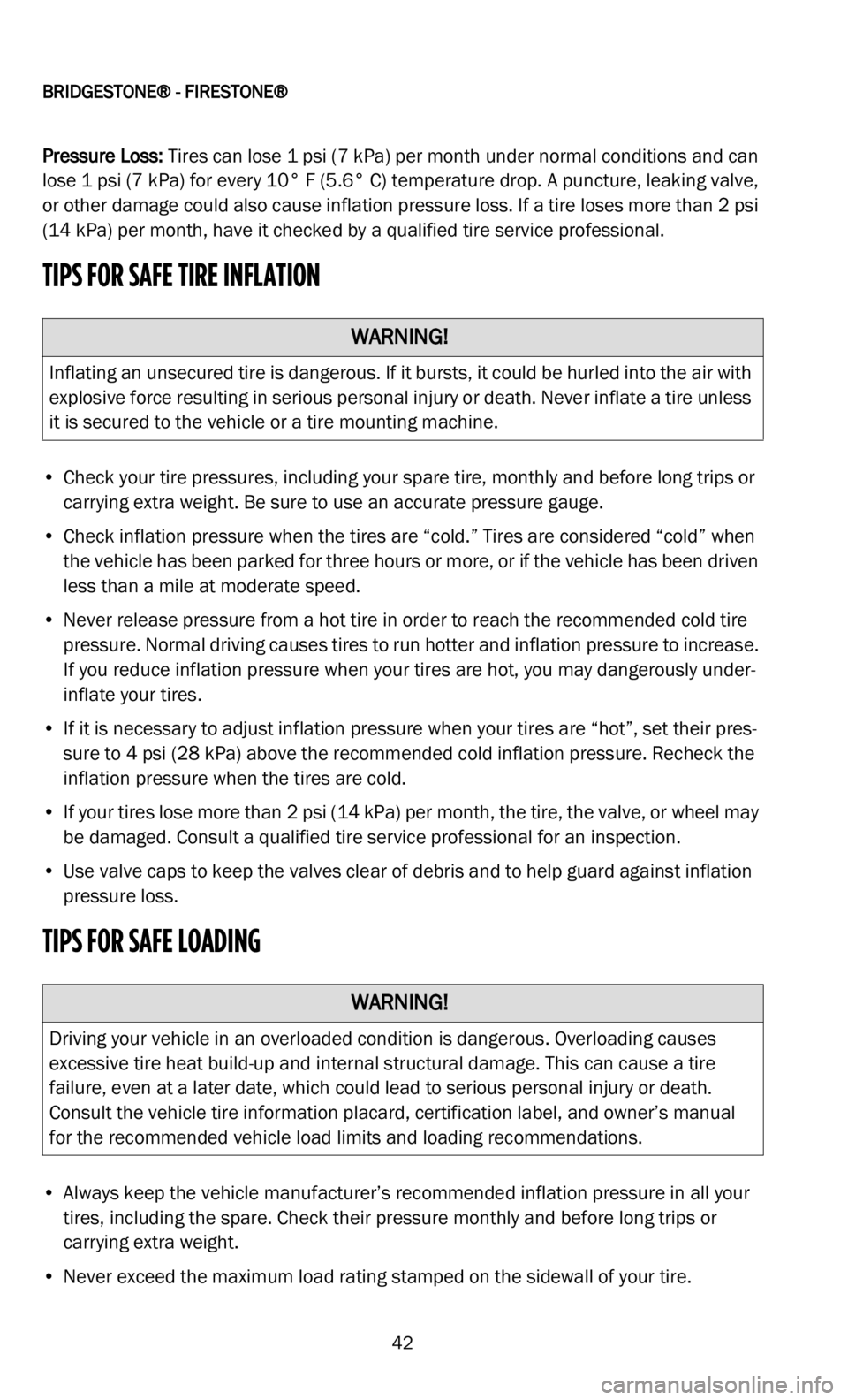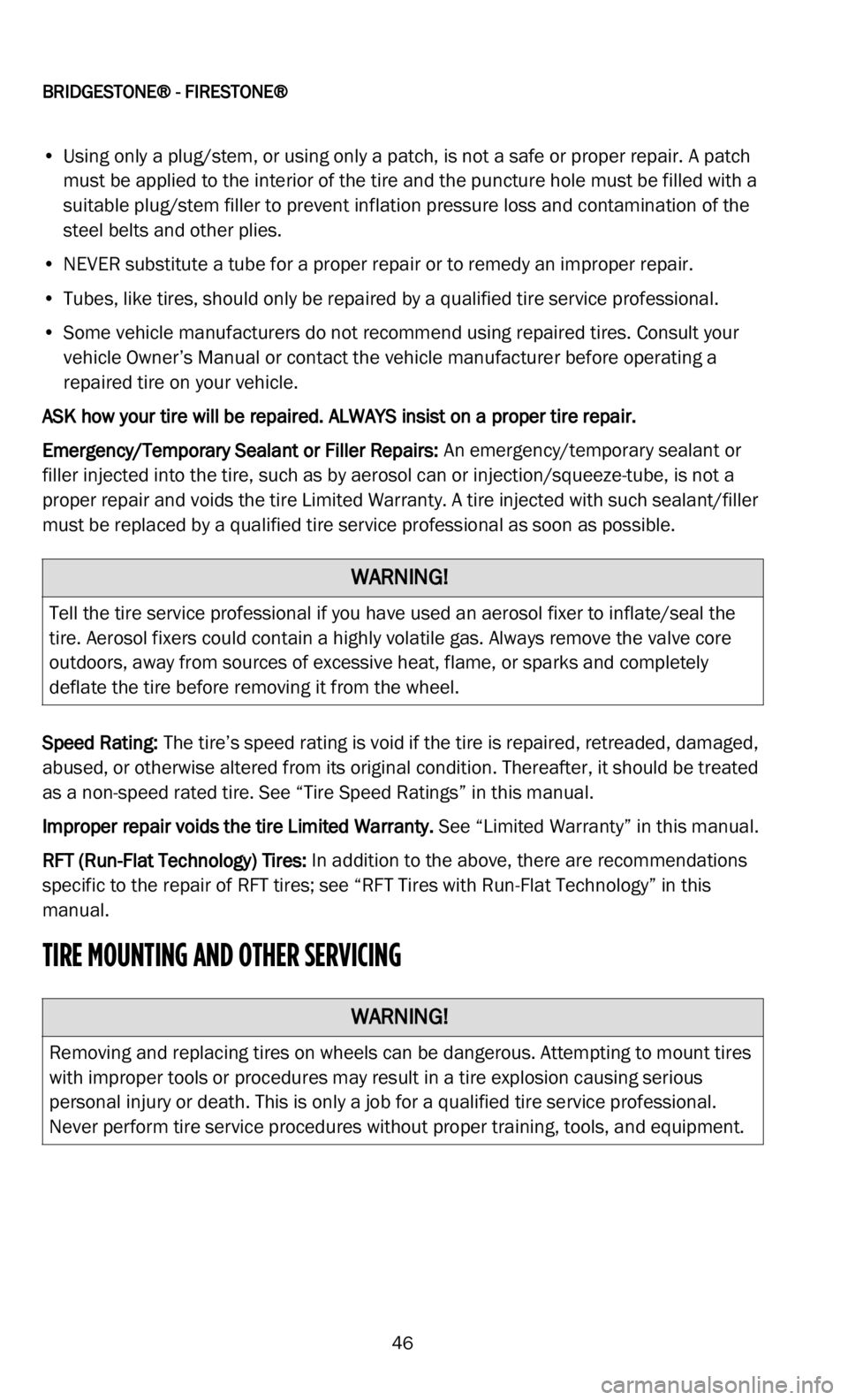run flat DODGE DURANGO 2022 Vehicle Warranty
[x] Cancel search | Manufacturer: DODGE, Model Year: 2022, Model line: DURANGO, Model: DODGE DURANGO 2022Pages: 200, PDF Size: 6.72 MB
Page 12 of 200

TIRES
11
Tire Pressures For High Speed Operation
FCA US LLC advocates driving at safe speeds and within posted speed limits. Where
speed limits or conditions are such that the vehicle can be driven at high speeds,
maintaining correct tire inflation pressure is very important. Increased tire pressure and
reduced vehicle loading may be required for high-speed vehicle operation. Refer to an
authorized tire dealer or original equipment vehicle dealer for recommended safe
operating speeds, loading and cold tire inflation pressures.
Radial Ply Tires
Tire Repair
If your tire becomes damaged, it may be repaired if it meets the following criteria:
• The tire has not been driven on when flat.
• Th
e damage is only on the tread section of your tire (sidewall damage is not repair -
a b
le).
• The puncture is no greater than a ¼ of an inch (6 m
m).
Consult an authorized tire dealer for tire repairs and additional information.
Damaged Run Flat tires, or Run Flat tires that have experienced a loss of pressure should
be
replaced immediately with another Run Flat tire of identical size and service
description (Load Index and Speed Symbol).
Run Flat Tires — If Equipped
Run Flat tires allow you the capability to drive 50 miles (80 km) at 50 mph (80 km/h)
aft
er a rapid loss of inflation pressure. This rapid loss of inflation is referred to as the Run
Flat mode. A Run Flat mode occurs when the tire inflation pressure is of/or below 14 psi
(96 kPa). Once a Run Flat tire reaches the Run Flat mode, it has limited driving
capabilities and needs to be replaced immediately. A Run Flat tire is not repairable.
It is not recommended to drive a vehicle loaded at full capacity or to tow a trailer while a
tir
e is in the Run Flat mode.
See the Tire Pressure Monitoring System (TPMS) section for more information.
WARNING!
High speed driving with your vehicle under maximum load is dangerous. The added
strain on your tires could cause them to fail. You could have a serious collision. Do not
drive a vehicle loaded to maximum capacity at continuous speeds above 75 mph
(1 2
0 km/h).
WARNING!
Combining radial ply tires with other types of tires on your vehicle will cause your
vehicle to handle poorly. The instability could cause a collision. Always use radial ply
tires in sets of four. Never combine them with other types of tires.
Page 25 of 200

BFGOODRICH® TIRES
24
DRIVING ON ANY TIRE THAT DOES NOT HAVE THE CORRECT INFLATION PRESSURE
IS DANGEROUS
Any underinflated tire builds up excessive heat that may result in sudden tire destruction.
If tires are supplied as original equipment, refer to the tire decal on the vehicle (check
vehicle and/or vehicle Owner’s Manual for decal location) for the recommended
operating pressures. For replacement tires, the correct inflation pressure will be provided
by your tire retailer; if not, refer to the vehicle decal.
These inflation pressures must be maintained as a minimum. However, do not exceed
th
e maximum pressure rating indicated on the tire sidewall.
CHECK THE COLD INFLATION PRESSURE IN ALL YOUR TIRES, INCLUDING THE SPARE, AT
LE A
ST ONCE EACH MONTH
Failure to maintain correct inflation may result in improper vehicle handling and may
c a
use rapid and irregular tire wear, sudden tire destruction, loss of vehicle control and
serious personal injury. Therefore, inflation pressures should be checked at least once
each month and always prior to long distance trips. This applies to all tires, including
sealant types, and Self-Supporting tires which are as susceptible to losing air pressure
as any other type of tire if not properly maintained.
UNDERINFLATION
It is impossible to determine whether tires are properly inflated by simply looking at them.
It is almost impossible to “feel or hear” when a tire is being run underinflated or nearly
flat. Tires must be checked monthly with a tire pressure gauge.
Pressures should be checked when tires are cold, in other words, before they have been
d r
iven on. Driving, even for a short distance, causes tires to heat up and air pressure to
increase.
Checking pressure when tires are hot:
If pressures are checked after tires have been driven for more than three minutes or
m o
re than 1 mile, (1.6 km) the tires become hot and the pressures will increase by
a p
proximately 4 psi. Therefore when the tire pressure is adjusted under these
conditions, it should be increased to a gauge reading of 4 psi greater than the
recommended cold inflation pressure.
Check cold pressure as soon as possible, preferably within 24 hours. “Bleeding” air from
h o
t tires could result in underinflation. Use an accurate tire gauge to check pressures.
Never allow children to inflate or deflate tires. For Example Only:
Gauge reading of hot tire:
32 psi (220 kPa)
If recommended cold inflation pressure is: 30 psi (205 kPa)
Desired gauge reading of hot tire 30 + 4 psi = 34 psi (205 + 30 = 235 kPa)
Therefore: add 2 psi (15 kPa)
Page 26 of 200

BFGOODRICH® TIRES
25
TIRE PRESSURE MONITORING SYSTEM (TPMS)
Your vehicle may be equipped with a Tire Pressure Monitoring System (TPMS) that is
designed to monitor the pressure of tires mounted on your vehicle and sends a signal to
the driver if a tire pressure falls below a predetermined level. A TPMS should not replace
monthly manual pressure checks for all four tires and the spare. We recommend that you
manually monitor and check tire pressure inflation with a pressure gauge.
Your tires should have the recommended pressure listed by your vehicle’s manufacturer.
Th
is information can be found in the vehicle Owner’s Manual and often on a placard
located in the vehicle’s door jamb, inside the fuel hatch, or on the glove compartment
door. If you have a plus size fitment that requires a higher inflation pressure, your TPMS
will require re-calibration to the new inflation pressure. Refer to your tire dealer/installer
of plus size tires for proper inflation pressure.
We recommend checking air pressure once each month, and before a long trip. Whether
y o
u have a full-sized or mini-spare, make sure that it is properly inflated as well. If the
TPMS generates improper monitoring or signals we recommend that you consult your
Owner’s Manual provided with your vehicle and follow up with FCA US LLC.
TIRE SPINNING
Do not spin wheels in excess of 35 mph (55 km/h) as indicated on the speedometer.
Ex
cessive speed in a free-running, unloaded tire can cause it to “explode” from
centrifugal force. The energy released by such an explosion is sufficient to cause serious
physical injury or death. Never allow anyone to stand near or behind the spinning tire.
When in mud, sand, snow, ice or other slippery conditions, do not engage in excessive
w h
eel spin. Accelerating the motor excessively, particularly with automatic transmission
vehicles, may cause a drive tire that has lost traction to spin beyond its speed capability.
This is also true when balancing a drive tire/wheel assembly on the vehicle using the
vehicle engine to spin the tire/wheel assembly.
HIGH SPEED DRIVING CAN BE DANGEROUS
Correct inflation pressure is especially important. However, at high speeds, even with the
correct inflation pressure, a road hazard, for example is more difficult to avoid and if
contact is made, has a greater chance of causing tire damage than at a lower speed.
Moreover, driving at high speed reduces the reaction time available to avoid accidents
and bring your vehicle to a safe stop.
If you see any damage to a tire or wheel, replace it with the spare at once and visit a
pa
rticipating BFGoodrich® Tire Retailer.
Exceeding the maximum speeds shown on the following page for each type of
B F
Goodrich® tire will cause the tire to build up excessive heat which can cause tire
damage that could result in sudden tire destruction and rapid air loss. Failure to control
a vehicle when one or more tires experience a sudden air loss can lead to an accident.
In any case, you should not exceed reasonable speeds as indicated by the legal limits
a n
d driving conditions.
Page 29 of 200

BFGOODRICH® TIRES
28
All tires will wear out faster when subjected to high speeds as well as hard cornering,
rapid starts, sudden stops, frequent driving on roads which are in poor condition, and off
road use. Roads with holes and rocks or other objects can damage tires and cause
misalignment of your vehicle. When driving on such roads, drive carefully and slowly, and
before driving again at normal or highway speeds, examine your tires for any damage,
such as cuts, bulges, penetrations, unusual wear patterns, etc.
WEAR BARS
BFGoodrich® tires contain “Wear-Bars” in the grooves of the tire tread which show up
when only 2/32 of an inch (1.6 mm) of tread is remaining. At this stage, your tires must
b e
replaced. Tires worn beyond this stage are extremely dangerous.
DO NOT OVERLOAD - DRIVING ON ANY OVERLOADED TIRE IS DANGEROUS
The maximum load rating of your tires is molded on the tire sidewall. Do not exceed this
ra
ting. Follow the loading instructions of FCA US LLC and this will ensure that your tires
are not overloaded. Tires which are loaded beyond their maximum allowable loads for
the particular application will build up excessive heat that may result in sudden tire
destruction.
Do not exceed the Gross Axle Weight Rating (GAWR) for any axle on your vehicle.
TRAILER TOWING
If you anticipate towing a trailer, you should visit any BFGoodrich® tire retailer for advice
concerning the correct size tire and pressures. Tire size and pressures will depend upon
the type and size of trailer and hitch utilized, but in no case must the maximum cold
inflation pressure or tire load rating be exceeded. Check the tire decal and the Owner’s
Manual supplied by FCA US LLC for further recommendations on trailer towing.
WHEEL ALIGNMENT AND BALANCING ARE IMPORTANT FOR SAFETY AND MAXIMUM
MI
LEAGE FROM YOUR TIRES
CHECK HOW YOUR TIRES ARE WEARING AT LEAST ONCE EACH MONTH
If your tires are wearing unevenly, such as the inside shoulder of the tire wearing faster
th
an the rest of the tread, or if you detect excessive vibration, your vehicle may be out of
alignment or balance. These conditions not only shorten the life of your tires but
adversely affect the handling characteristics of your vehicle, which could be dangerous.
If you detect irregular wear or vibration, have your alignment and balance checked
immediately. Tires which have been run underinflated will show more wear on the
shoulders than in the center of the tread.
TIRE MIXING
BFGoodrich® tires are radial tires and for best performance it is recommended that the
same size and type of tire be used on all four wheel positions. Before mixing tires of
different types in any configuration on any vehicle, be sure to check the vehicle
manufacturer’s Owner‘s Manual for its recommendations.
Page 31 of 200

BFGOODRICH® TIRES
30
REPLACEMENT OF TWO TIRES
It is recommended that all four tires are replaced at the same time. However, whenever
on
ly two tires are replaced, the new ones should be put on the rear. The new tires, with
deeper tread, may provide better grip and water evacuation in wet driving conditions.
CUSTOMIZATION OF TIRES, WHEELS, OR SUSPENSION ON SUVS AND LIGHT
TRUCKS
Due to their size, weight and higher center of gravity, vehicles such as SUVs and light
trucks do not
have the same handling characteristics as automobiles. Because of these
differing characteristics, failure to operate your SUV/truck in a proper and safe manner
can increase the likelihood of vehicle rollover. Modifications to your SUV/truck tire size,
tire type, wheels or suspension can change its handling characteristics and further
increase the likelihood of vehicle rollover. Whether your SUV/truck has the original
equipment configuration for tires, wheels and suspension or whether any of these items
have been modified, always drive safely, avoid sudden, sharp turns or lane changes and
obey all traffic laws. Failure to do so may result in loss of vehicle control leading to an
accident and serious injury or death.
TIRE ALTERATIONS
Do not make or allow to be made any alterations on your tires. Alterations may prevent
p r
oper performance, leading to tire damage which can result in an accident. Tires which
become unserviceable due to alterations such as trueing, whitewall inlays, addition of
balancing or sealant liquids, or the use of tire dressing containing petroleum distillates
are excluded from warranty coverage.
REPAIRS - WHEREVER POSSIBLE, SEE YOUR BFGOODRICH® TIRE RETAILER AT ONCE
If any BFGoodrich® tire sustains a puncture, have the tire demounted and thoroughly
i n
spected by any BFGoodrich® tire retailer for possible damage that may have occurred.
A tread area puncture in any BFGoodrich® passenger or light truck tire can be repaired
p r
ovided that the puncture hole is not more than 1/4 of an inch in diameter, not more
than one radial cable per casing ply is damaged, and the tire has not been damaged
further by the puncturing object or by running underinflated. Tire punctures consistent
with these guidelines can be repaired by following the Rubber Manufacturers Association
(RMA) recommended repair procedures.
TIRE REPAIRS
Repairs of all tires must be of the combined plug and inside patch type. Plug only repairs
are improper. A tire should be removed from the rim and inspected prior to repair. Any
tire repair done without removing the tire from the rim is improper. An improperly
repaired tire will cause further damage to the tire by either leaking air or allowing air,
moisture and contaminants to enter the structure of the tire. An improperly repaired tire
can fail suddenly at a later date.
Never repair a tire with less than 2/32 of an inch tread remaining. At this tread depth,
t h
e tire is worn out and must be replaced.
Page 36 of 200

35
BRIDGESTONE® - FIRESTONE®
TIRE MAINTENANCE, SAFETY and WARRANTY MANUAL ORIGINAL EQUIPMENT
PASSENGER and LIGHT TRUCK TIRES (Including RFT Tires with Run-Flat Technology)
Congratulations!
Your new vehicle comes equipped with quality BRIDGESTONE® or FIRESTONE® brand
tir
es.
To ensure optimum tire performance and reduce the risk of a tire failure, Bridgestone®
Fi r
estone® North American Tire, LLC strongly recommends you read and follow all
maintenance and safety information contained in this manual. In addition, we
recommend periodic inspection and maintenance, if necessary, by a qualified tire service
professional.
Inflate.
Check your tire pressure monthly.
Rotate.
Rotate your tires as recommended by the vehicle manufacturer or ever 5,000 miles.
Evaluate.
Routinely look for signs of tread wear or damage.
TIRE CARE BASICS
Quick Reference Guide to Maintenance for All Tires, Including the Spare.
TIRE INFLATION PRESSURE
Tires can lose 1 psi (pound per square inch) per month under normal conditions.
Additionally, tires can lose 1 psi for every 10°F temperature drop.
Page 43 of 200

BRIDGESTONE® - FIRESTONE®
42
Pressure Loss: Tires can lose 1 psi (7 kPa) per month under normal conditions and can
lose 1 psi (7 kPa) for every 10° F (5.6° C) temperature drop. A puncture, leaking valve,
or other damage could also cause inflation pressure loss. If a tire loses more than 2 psi
(14 kPa) per month, have it checked by a qualified tire service professional.
TIPS FOR SAFE TIRE INFLATION
• Check your tire pressures, including your spare tire, monthly and before long trips or carrying extra weight. Be sure to use an accurate pressure gauge.
• C heck inflation pressure when the tires are “cold.” Tires are considered “cold” when
t
he vehicle has been parked for three hours or more, or if the vehicle has been driven
less than a mile at moderate speed.
• N ever release pressure from a hot tire in order to reach the recommended cold tire
p
ressure. Normal driving causes tires to run hotter and inflation pressure to increase.
If you reduce inflation pressure when your tires are hot, you may dangerously under -
inflate your tires.
• I f it is necessary to adjust inflation pressure when your tires are “hot”, set their pres -
s
ure to 4 psi (28 kPa) above the recommended cold inflation pressure. Recheck the
i n
flation pressure when the tires are cold.
• I f your tires lose more than 2 psi (14 kPa) per month, the tire, the valve, or wheel may
b
e damaged. Consult a qualified tire service professional for an inspection.
• U se valve caps to keep the valves clear of debris and to help guard against inflation
p
ressure loss.
TIPS FOR SAFE LOADING
• Always keep the vehicle manufacturer’s recommended inflation pressure in all your tires, including the spare. Check their pressure monthly and before long trips or
carrying extra weight.
• N ever exceed the maximum load rating stamped on the sidewall of your tire.
WARNING!
Inflating an unsecured tire is dangerous. If it bursts, it could be hurled into the air with
explosive force resulting in serious personal injury or death. Never inflate a tire unless
it is secured to the vehicle or a tire mounting machine.
WARNING!
Driving your vehicle in an overloaded condition is dangerous. Overloading causes
excessive tire heat build-up and internal structural damage. This can cause a tire
failure, even at a later date, which could lead to serious personal injury or death.
Consult the vehicle tire information placard, certification label, and owner’s manual
for the recommended vehicle load limits and loading recommendations.
Page 47 of 200

BRIDGESTONE® - FIRESTONE®
46
• Using only a plug/stem, or using only a patch, is not a safe or proper repair. A patch must be applied to the interior of the tire and the puncture hole must be filled with a
suitable plug/stem filler to prevent inflation pressure loss and contamination of the
steel belts and other plies.
• N EVER substitute a tube for a proper repair or to remedy an improper repair.
•
Tubes, like tires, should only be repaired by a qualified tire service professional.
•
Some vehicle manufacturers do not recommend using repaired tires. Consult your
v
ehicle Owner’s Manual or contact the vehicle manufacturer before operating a
repaired tire on your vehicle.
ASK how your tire will be repaired. ALWAYS insist on a proper tire repair.
Emergency/Temporary Sealant or Filler Repairs: A
n emergency/temporary sealant or
filler injected into the tire, such as by aerosol can or injection/squeeze-tube, is not a
proper repair and voids the tire Limited Warranty. A tire injected with such sealant/filler
must be replaced by a qualified tire service professional as soon as possible.
Speed Rating: T
he tire’s speed rating is void if the tire is repaired, retreaded, damaged,
abused, or otherwise altered from its original condition. Thereafter, it should be treated
as a non-speed rated tire. See “Tire Speed Ratings” in this manual.
Improper repair voids the tire Limited Warranty. S
ee “Limited Warranty” in this manual.
RFT (Run-Flat Technology) Tires: I
n addition to the above, there are recommendations
specific to the repair of RFT tires; see “RFT Tires with Run-Flat Technology” in this
manual.
TIRE MOUNTING AND OTHER SERVICING
WARNING!
Tell the tire service professional if you have used an aerosol fixer to inflate/seal the
tire. Aerosol fixers could contain a highly volatile gas. Always remove the valve core
outdoors, away from sources of excessive heat, flame, or sparks and completely
deflate the tire before removing it from the wheel.
WARNING!
Removing and replacing tires on wheels can be dangerous. Attempting to mount tires
with improper tools or procedures may result in a tire explosion causing serious
personal injury or death. This is only a job for a qualified tire service professional.
Never perform tire service procedures without proper training, tools, and equipment.
Page 55 of 200

BRIDGESTONE® - FIRESTONE®
54
TIRE REGISTRATION
Registration of your tires is an important safety precaution since it enables the
manufacturer to notify you in the event of a recall. When you purchase replacement tires,
the retailer will provide a registration card on which the tire identification numbers have
been recorded; fill in your name and address on the card and mail it promptly. Some
retailers may submit the registration for you. You do not need to register tires which come
as original equipment on new vehicles—the vehicle and tire manufacturers handle that
for you.
RFT TIRES WITH RUN-FLAT TECHNOLOGY
If your vehicle is equipped with Bridgestone® or Firestone® brand RFT
tires, this chapter presents specific maintenance and safety issues
a s
sociated with these tires that are in addition to those covered elsewhere in this
manual.
What is RFT? Run-Flat Technology tires are extraordinary tires that utilize specially
d e
signed components to temporarily support your vehicle in the event of inflation
pressure loss, such as from a puncture. This gives you the ability to drive to a convenient
and safe location to change your tire (if equipped with a spare) or have it inspected for
possible repair or replacement.
Naturally, certain run-flat and low pressure operating limitations apply, which varies
ac
cording to the specific self-supporting tire design. Like all tires, during normal
operation, they must be properly inflated and maintained. Regardless of the design or
quality, no tire is indestructible.
RFT — How to Identify: B
ridgestone® and Firestone® brand tires are marked on the
sidewalls, near the wheel, with the RFT logo (shown above).
RFT INFLATION PRESSURE
Like other tires, RFT tires need proper inflation pressure maintenance for safe operation
an
d to achieve the maximum tire life and performance. Check inflation pressures
monthly and before long trips or carrying extra weight. Use an accurate tire gauge and
check pressures when the tires are cold. Follow the vehicle manufacturer’s
recommendation for inflation pressure settings as indicated on the vehicle tire
information placard and/or in the vehicle Owner’s Manual. Do not forget the spare, if
applicable. See “Tire Inflation Pressure” in this manual.
TIRE PRESSURE MONITORING SYSTEM (TPMS)
A functioning Tire Pressure Monitoring System (TPMS) must be used with your Run Flat
tires. These tires ride so well even without inflation pressure, the TPMS may be necessary
to alert you of an inflation pressure loss condition. When alerted, follow the instructions
in your vehicle Owner’s Manual and see “Run-Flat or Low Tire Pressure Operation,” the
following section in this manual.
Page 56 of 200

BRIDGESTONE® - FIRESTONE®
55
The vehicle or TPMS manufacturer may advise checking the TPMS regularly to confirm it
is in working order. In addition, a new pressure sensor, certain components, or
reprogramming may be necessary when a tire is serviced. Consult your vehicle Owner’s
Manual, vehicle manufacturer, or a Bridgestone® Firestone® Run-Flat Certified Retailer
for questions regarding TPMS operation and service.
RUN-FLAT OR LOW TIRE PRESSURE OPERATION
General Instructions
The Tire Pressure Monitoring System (TPMS) required in your vehicle may have different
m e
thods of alerting you when your tire has lost inflation pressure. The international
standard for the definition of run-flat operation is pressure at or below 10 psi (70 kPa);
however, some vehicle manufacturers may have established a different pressure limit.
Consult your vehicle Owner’s Manual for the details of your TPMS. Once the TPMS has
indicated that a tire has reduced inflation pressure, the run-flat mode of operation has
commenced. During this phase of operation, please follow these instructions:
• Reduce speed as much as safely and reasonably possible; do not exceed 50 m
ph
(8
0 km/h). The greater the speed, the less distance the tire can travel.
• Avoid abrupt or aggressive acceleration, braking, or cornering maneuvers as much as
s
afely and reasonably possible. Pot holes and other road hazards should be avoided.
Careful driving limits potential damage to the tire, wheel, and vehicle.
• Proceed to a safe and convenient location for tire service as soon as possible.
Take
note of your mileage; your operation distance is limited. See "Distance—How Far You
Can Drive,” the next section in this manual.
• If an unusual vibration or vehicle handling difficulty arises, stop driving as soon as
s
afely and reasonably possible. The tire may be about to suddenly fail. Release the
accelerator and gradually reduce speed. The tire will need to be replaced before
proceeding.
• If towing a trailer, stop driving as soon as safely and reasonably possible. In this condi -
t
ion, it is potentially dangerous to operate a vehicle/trailer combination. I
f possible,
disconnect the trailer and proceed as noted above. Do not continue to tow any trailer
until proper tire service or replacement has been performed.
• Do not touch a tire recently run-low or run-flat (it may be very hot).
Allow the tire to cool
before handling.
WARNING!
Serious personal injury or death may result from a tire failure or accident due to
improper run-flat or low tire pressure operation. Read and follow the instructions
below, and the other maintenance and safety recommendations elsewhere in this
manual.